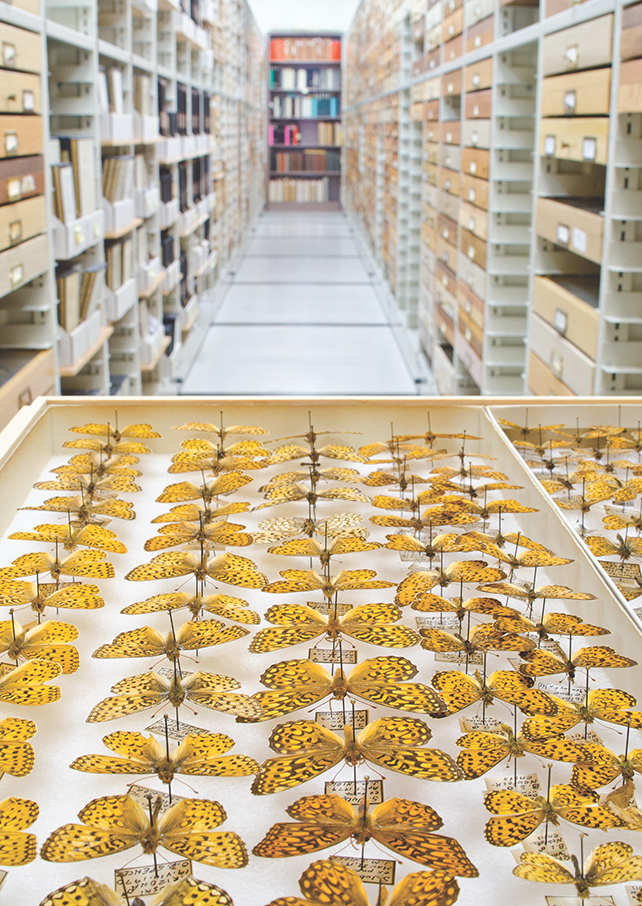
Tens of millions of insect and spider specimens lie pinned into drawers, folded in envelopes, or are floating in jars of alcohol within the major entomology collections of California. Each specimen’s tiny labels, usually about the size of a honeybee, hold information about its collector, where and when it was found, its species name, and by whom it was first identified. Such historical data is irreplaceable and will allow scientists to study how landscape and climate changes in California have influenced the biology and distribution of the most diverse animal group. Until now, however, this information has been locked in the drawers and cabinets of nine museums scattered throughout the state, limiting access for researchers and hobbyists alike. To begin unlocking these data, The Essig Museum of Entomology at UC Berkeley is leading a collaborative effort to digitize information for over one million specimens and publish it online. Dubbed Calbug, this enormous undertaking has inspired a creative approach: rather than hiring a team of people to digitally catalog every specimen, the Essig Museum has opened its virtual doors to the public and turned an overwhelming task into an engaging citizen science project.
 An insect specimen from the Essig Museum. Volunteers transcribe information from the labels, using an image like this. Credit: Marek Jakubowski
An insect specimen from the Essig Museum. Volunteers transcribe information from the labels, using an image like this. Credit: Marek Jakubowski
The citizen science approach is more than just an outreach tactic. The high volume data mining that can be achieved through such massive cooperation is necessary for timely completion of the project. “If we stopped all other work in the museum and dedicated our already limited staff to the process of databasing collections, it would take many decades if not a century to digitize current holdings,” says Dr. Peter Oboyski, collection manager of the Essig Museum. In today’s complex and data-hungry world, this problem is not unique. Large stores of data are increasingly necessary to uncover mysteries about our changing environment and, as Calbug demonstrates, the scope of data gathering often goes beyond what trained scientists can manage alone. In response to this trend, the number of research projects that engage citizen scientists has grown dramatically from just a few in the mid-1900s to many hundreds (or even thousands) today.
In order to manage its online catalogs, Calbug has partnered with Zooniverse, one of the most prominent international citizen science organizations active today. In 2007, Zooniverse began its crowdsourcing venture with Galaxy Zoo, an ongoing astronomy project in which volunteers scroll through millions of satellite images to classify galaxies based on shape. Galaxy Zoo accumulated over 100,000 active volunteers after just 9 months, a success rate that Calbug hopes to mimic. Today, Zooniverse features 18 projects and engages over 800,000 individuals.
Calbug is hosting its collection on Notes from Nature, a recent addition to Zooniverse that allows volunteers enter label information from natural history specimens online. Two other collections are currently featured on the site—a consortium of 222 plant collections in the southeastern US, known as SERNEC, and bird ledgers from the Natural History Museum of London—and the platform is showing early signs of success. In the first few days of launching Notes from Nature in late April, over 5,000 individuals participated from all over the world, including both anonymous users and registered volunteers who sign in to track their overall progress. To date, close to 4,000 citizen scientists have registered and over 300,000 records are now complete. Building on these initial successes, Notes from Nature plans to eventually include additional museum collections.
 A butterfly collection at the museum. Credit: Marek Jakubowski
A butterfly collection at the museum. Credit: Marek Jakubowski
Scientists from the Essig Museum and elsewhere are not the only ones enjoying the fruits of this collective labor. Volunteer comments on the Notes from Nature discussion boards and blogs make it clear that the task of transcribing collection information from over the past century can ignite the imagination. “I love reading the careful notes and imagining the collector in the middle of nowhere, in the sun or rain, finding their plant [or insect] and taking their samples and data,” said Jonathon Moore, a volunteer and research scientist from the UK. Maggie, a mother and homemaker from Colorado, said that “while I type, it’s easy to picture the area I’m transcribing, and it’s never the same as the one before.” Another volunteer marveled at Jerry Powell, Director Emeritus of the Essig Museum and moth specialist who, as she pointed out, “has about 60 years-worth of specimens…I’m starting to think that he is a vampire who has lived forever.” Images of metallic green beetles, striking blue butterflies, and spot-winged dragonflies that accompany collection labels also spark newfound admiration for insects. As one citizen scientist exclaimed, “I never realized the many differences in markings of insects before!” Others have mentioned that they are now more observant of insects in nature.
The rich experience that citizen scientists have while transcribing data has kept many of them coming back for more. Discussion boards are peppered with proud announcements upon completion of 1,000, 2,000, and 4,000 specimens, followed by congratulations from other Notes from Nature volunteers. Each individual is armed with the knowledge that they are part of a larger community of citizen scientists, honoring the hard work of many researchers who have come before them, and contributing to future discoveries about changes in organisms and ecology over the past century or more. As Moore put it, “I like to compare it to an ant, which alone doesn’t get very far, but together with thousands of others can build an ant hill.”
This article is part of the Fall 2013 issue.



